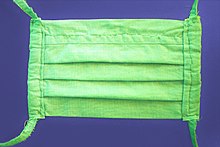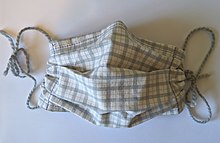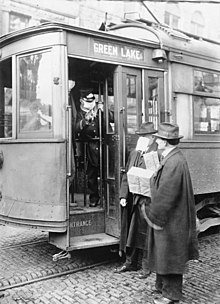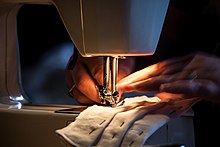Cloth face mask
![]()
This article is about non-standardized fabric masks. For standardized medical masks, see Mouth-nose protection and Protective mask#Infection protection masks.
An everyday mask or (official) mouth-nose-covering (MNB) is a tailored piece of fabric worn over the nose and mouth to filter the air breathed. Other terms include community mask, makeshift mouth-nose mask, makeshift mask, or DIY homemade mask.
In Austria, the mask is officially called a (simple) mouth-nose protection (MNS) and legally a mechanical mouth-nose protection device or a mechanical protection device covering the mouth and nose area [and fitting tightly].
It is usually made of cotton fabric, which is sewn in folds or tailored to the shape of the face. It is fixed to the ears with elastic bands or to the back of the head and neck with retaining straps. If a metal wire is incorporated into the fabric above the nose, the mask can be adjusted more closely to the nose and thus fixed more closely to the face.
Makeshift masks may not be commercially "marketed as medical devices or items of personal protective equipment and may not be advertised as having corresponding benefits or protective effects", but may be used exclusively in the private environment (and in Bavaria by schoolchildren during lessons, from 7 June 2021 only up to the 4th grade), as - unlike medical mouth-nose protection (MNS) and respiratory protection masks such as FFP2 and FFP3 masks - they are not yet subject to regulation. There are therefore few reliable, generalisable statements on their effectiveness as protection against the transmission of infections or fine dust.
Working paper CWA 17553:2020 for face masks for use in public environments (community face coverings), published by the European Committee for Standardization (CEN) in June 2020, describes for the first time minimum requirements for design, manufacture and performance evaluation.

A double layer of cloth can be used as a makeshift mouth/nose covering.

Hand-sewn makeshift mouth-nose mask made of cotton with folds ironed in before sewing, can be disinfected by ironing

Homemade everyday masks with elastic bands adapted to the shape of the face

Hand-sewn everyday mask made of two layers of cotton fabric with retaining straps

Homemade everyday mask with retaining straps
History
The first recorded use of fabric face masks was by French surgeon Paul Berger during an operation in Paris in 1897.
Masks came into use in the early 20th century to protect against infection. A design by the Chinese physician Wu Lien-teh, who worked at the Chinese imperial court during a plague epidemic in the autumn of 1910, was the first to be empirically tested. It inspired masks used during the Spanish flu of 1918. The first study of masks worn by health care workers took place in 1918.
The Spanish flu (1918-1920) claimed 390,000 lives in Japan. At the time, the Japanese government put up posters with the message, "Beware of germs! You risk your life if you don't wear a mask!" Since then, the prevalence of face masks in Japan has steadily increased. Today, cloth masks are an everyday sight in public spaces in Japan; these are often single-use cellulose masks.
When Sweden was severely affected by the Spanish flu in the middle of 1918, the effectiveness of face masks was recognized within a few weeks:
["All these persons, who must be in constant contact with the sick [...], were equipped with face masks which, similar to the war gas masks, covered the whole face up to above the chin, leaving the eyes free. [...] The reason for the introduction of these masks was the fact, which had been established by our most eminent clinicians and hygienists, that the transmission of pathogens takes place more by indirect-contagious means, i.e. through the air as a medium, than from person to person (direct-contagious), from which it follows that the air of the sick room, which is particularly saturated with germs, also gives quite special opportunity for infection."
- Report of a Swedish doctor, quoted in the Fremden-Blatt, August 5, 1918.
Also in 1918, the wearing of masks was recommended in Switzerland:
"Prof. Galli-Valerio, at Lausanne, recommends that all persons who are afraid of contracting Spanish influenza should wear a mask, as the influenza is spread by saliva entering the nose, mouth, etc. The hygienic city service of Lausanne has made two models of protective masks, which have been tried in the hospital at Lausanne."
- Note in the Prager Tagblatt, 14 August 1918
By 1919 at the latest, it was known that the masks offered a certain degree of protection, despite all the problems associated with their use:
"As a prophylactic agent, the masks have been recommended from many quarters. Quite a number of models exist. The subsequent masks are very disliked by the nurses and the waiting staff, as they become slightly damp during work and then hardly allow any air to pass through. Lenz does state that one can get used to the mask. It seems to work with doctors, but not with the somewhat heavier working staff. Infections have also occurred in spite of strict wearing of the masks, but only slight illnesses. So the masks seem to provide a certain protection."
- Wiener klinische Rundschau, August 5, 1918
In the 1940s, masks made of cheesecloth were used in the USA to protect nurses from tuberculosis.
In the 1960s, their use in industrialized countries declined for hygienic reasons in favor of modern medical masks. However, they continued to be used in developing countries. Cloth face masks were largely displaced in the 1960s in industrialized countries by industrially manufactured disposable products made of multilayer nonwoven fabric. However, simple fabric masks continue to be used during infectious outbreaks, such as in Asia during the 2002/2003 SARS pandemic and in West Africa during the 2014 to 2016 Ebola fever epidemic. During the COVID 19 pandemic, which has been ongoing since 2020, mandatory wearing of face masks has been introduced in many countries (see below).

Play media file Video about the origin of the face mask

During the Spanish flu in 1918, a streetcar conductor in Seattle turns away a person trying to board without wearing a mask
Manufacture
Due to the individual production, the variety of manufacturing methods, patterns and products is very large.
Manufacturer
In the course of the COVID 19 pandemic, there was a short-lived need for medical mouth-nose protection. Because there was no stockpile of these supplies and the need could not be met quickly enough, makeshift masks were produced by private individuals and commercial manufacturers, such as numerous professional tailors and seamstresses; or by people who otherwise work as alteration tailors or in the costume departments of theatres, for example. Larger companies also entered production. Since then, cloth masks of various kinds have been offered in the trade. In addition, makeshift masks are made in countless households and by dedicated helpers and groups themselves.
Homemade masks
Instructions for sewing DIY masks ("do-it-yourself masks") have been published by various institutions, such as the city of Essen, as well as by celebrities, including fashion designer Guido Maria Kretschmer.
In the print media and on the Internet, various ways of producing masks without sewing have also been publicised, including by the American health authority CDC. According to this, suitable mouth-nose coverings can be made with the simplest means and without tools from common household materials.
Materials
Most often, cotton fabrics are used. Homemade masks can be made, for example, from worn T-shirts, bandanas, handkerchiefs, scarves, tube towels or towels. Scientists from Hong Kong invented a DIY mask from two types of tissue paper in February 2020.
According to a study by the Max Planck Institute for Chemistry, many materials commonly used in the household are suitable for the production of masks that can reduce the risk of infection with the coronavirus: in addition to various cotton fabrics, for example, paper towels from kitchen rolls or fleeces from vacuum cleaner bags. Subsequently, a major manufacturer of vacuum cleaner bags pointed out that the vacuum cleaner bags produced by the company were not designed for use as masks.
Makeshift masks differ from the legally regulated medical mouth-nose protective masks (standard: EN 14683:2019) and respirators, which are made of several layers of fabric as well as non-woven fabric that is shaped in a melt-blow process.

Sewing a makeshift mask
Questions and Answers
Q: What is a cloth facemask?
A: A cloth facemask is a face covering made of textiles that is used to cover the mouth and nose.
Q: What material is commonly used to make cloth facemasks?
A: Cotton is commonly used to make cloth facemasks.
Q: Who has been using cloth facemasks since the 19th century?
A: Healthcare professionals have been using cloth facemasks since the 19th century.
Q: Are cloth facemasks effective in protecting against air pollution?
A: Cloth facemasks may not be very effective in protecting against air pollution.
Q: Can cloth facemasks be effective in stopping the transmission of disease spread by droplets of liquid?
A: Depending on the design, cloth facemasks can be effective in stopping the transmission of disease spread by droplets of liquid.
Q: What do healthcare professionals often use instead of cloth facemasks?
A: Healthcare professionals often use surgical masks or respirators, which offer better protection than cloth facemasks.
Q: Why are cloth facemasks commonly used during the COVID-19 pandemic?
A: Cloth facemasks are commonly used during the COVID-19 pandemic, especially when surgical and other medical face coverings are not available.
Search within the encyclopedia